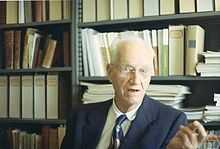Griffith C. Evans
| Griffith Conrad Evans | |
|---|---|
 | |
| Born | 11 May 1887 |
| Died | 8 December 1973 (aged 86) |
| Residence | United States |
| Nationality | American |
| Fields |
Potential theory Functional analysis Integral equations |
| Institutions |
Rice University University of California, Berkeley |
| Alma mater | Harvard University |
| Doctoral advisor | Maxime Bôcher |
| Doctoral students |
John Gergen Alfred Horn Kenneth May |
Griffith Conrad Evans (11 May 1887 – 8 December 1973) was a mathematician working for much of his career at the University of California, Berkeley. He is largely credited with elevating Berkeley's mathematics department to a top-tier research department,[1] having recruited many notable mathematicians in the 1930s and 1940s.
Biography
Evans earned his PhD at Harvard in 1910 under Maxime Bôcher with a dissertation on Volterra's Integral Equation, after which he did a post-doc for two years at the University of Rome on a Sheldon Fellowship from Harvard.[2] Evans was then appointed assistant professor at Rice University in 1912 and promoted to professor in 1916.[2] He married Isabel Mary John in 1917 and they would eventually have 3 children.[2] In 1934, he moved to University of California, Berkeley to chair the mathematics department.[3] Here, Evans was tasked with improving the department, including the initiation of a graduate program. Much of his success was due to his ability to recruit many notable research mathematicians, including Hans Lewy, Jerzy Neyman, and Alfred Tarski.[1] His own research work was in potential theory and mathematics applied to economics. He chaired Berkeley's department until 1949 and retired in 1955,[3] eventually becoming the namesake of Evans Hall at Berkeley.
Notable positions
- Chair, University of California, Berkeley Mathematics Department (1934–1949)
- President, American Mathematical Society (1939–1940)
- Member, National Academy of Sciences (1933)
Selected publications
- The logarithmic potential, discontinuous Dirichlet and Neumann problems. American Mathematical Society. 1927.
- Mathematical introduction to economics. McGraw Hill. 1930.[4]
- Stabilité et dynamique de la production dans l’économie politique. Gauthier-Villars. 1932.
- "On potentials of positive mass. I". Trans. Amer. Math. Soc. 37 (2): 226–253. 1935. doi:10.1090/s0002-9947-1935-1501785-8. MR 1501785.
- "On potentials of positive mass. II". Trans. Amer. Math. Soc. 38 (2): 201–236. 1935. doi:10.1090/s0002-9947-1935-1501809-8. MR 1501809.
- "Modern methods of analysis in potential theory". Bull. Amer. Math. Soc. 48 (3): 481–502. 1937. MR 1563577.
- "Continua of minimum capacity". Bull. Amer. Math. Soc. 47 (10): 717–733. 1941. doi:10.1090/s0002-9904-1941-07541-5. MR 0005261.
- Lectures on multiple valued harmonic functions in space. University of California Press. 1951.
- Functionals and their applications; selected topics including integral equations. Dover. 1964.
Biographical references
- Morrey, C. B., Jr.; Lewy, H.; Shephard, R. W.; Vaught, R. L. (May 1977), "Griffith Conrad Evans, Mathematics: Berkeley 1887-1973, Professor", 1977, University of California: In Memoriam, Berkeley, CA: University of California, Berkeley, pp. 102–103
- Morrey, Charles B., Jr. (1983), "Griffith Conrad Evans", in National Academy of Sciences of the United States of America, Biographical Memoirs, Biographical Memoirs 54, Washington, D.C.: National Academy Press, pp. 126–155, ISBN 0-309-03391-8.
- Rider, Robin E. (1985), "An opportune time: Griffith C. Evans and mathematics at Berkeley" (PDF), in Duren, Peter, A Century of Mathematics in America, Part II, History of Mathematics 2, Providence: American Mathematical Society, pp. 283–302, ISBN 0-8218-0130-9, MR 1003134, Zbl 0671.01027.
References
- ↑ 1.0 1.1 Kirby, R. (2008) Mathematics at Berkeley: A History, AMS Notices 55(10), 1237–1240.
- ↑ 2.0 2.1 2.2 Morrey, C. B. (1983) Griffith Conrad Evans, 1887-1973: A Biographical Memoir, National Academy of Sciences.
- ↑ 3.0 3.1 AMS Presidents: Griffith Evans
- ↑ Roos, Charles F. (1931). "Review: Mathematical introduction to economics, by Griffith C. Evans" (PDF). Bull. Amer. Math. Soc. 37 (5): 328–329. doi:10.1090/s0002-9904-1931-05136-3.
External links
|